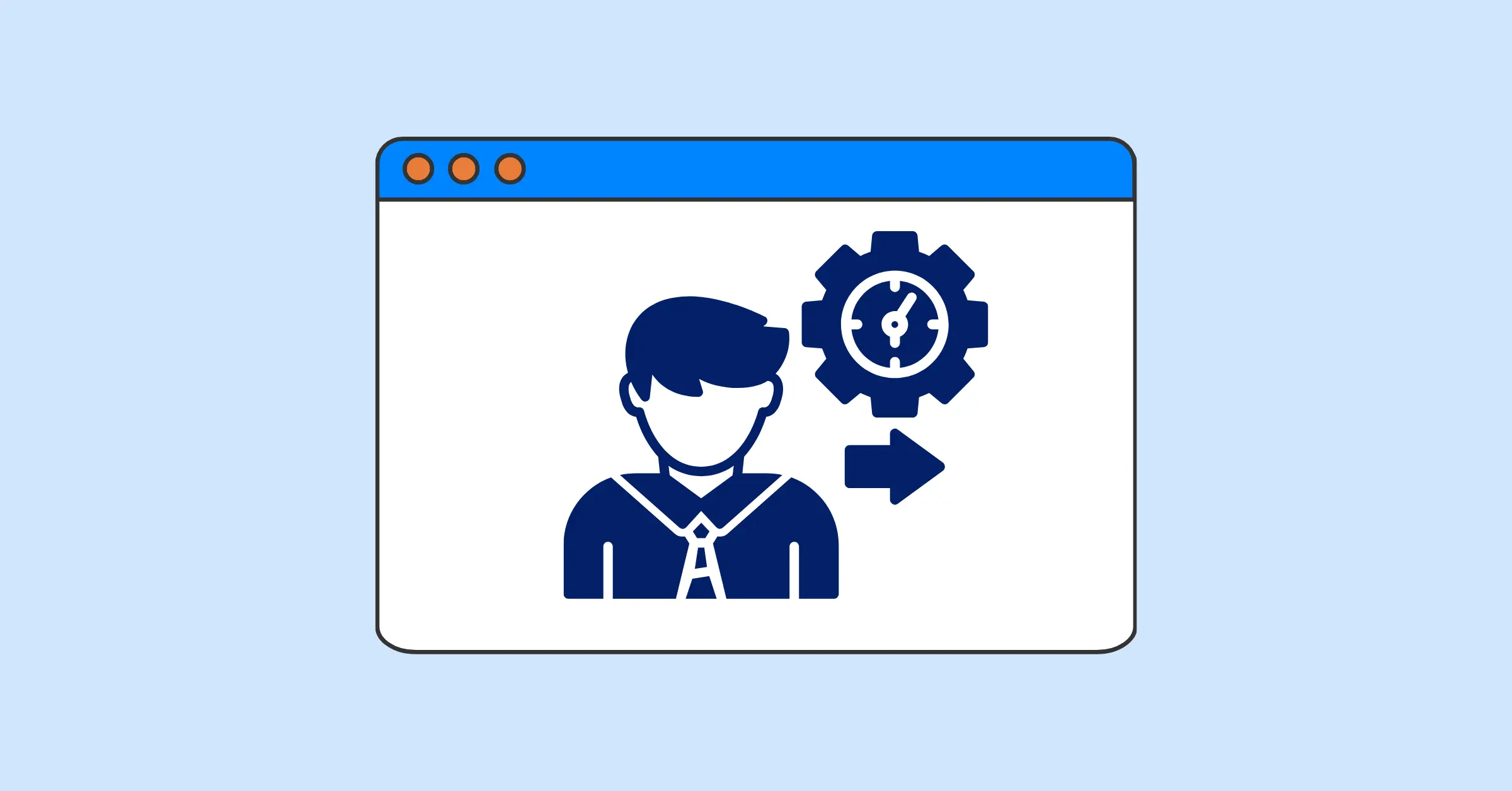Matrix Leave Management Explained: A Smarter Way to Handle Time Off in Complex Organizations
Discover how Matrix Leave Management revolutionizes time-off coordination for complex organizations, ensuring efficiency, compliance, and employee satisfaction.
Managing employee time off in large, complex organizations is a significant challenge. With cross-functional teams, multiple reporting lines, and global operations, coordinating leave requests while ensuring compliance and productivity can become chaotic. Matrix Leave Management provides a technology-driven solution to simplify this process. By leveraging a robust leave management system like TaskFord’s, organizations can manage absences with precision, ensuring transparency, fairness, and operational efficiency.
This blog explores what Matrix Leave Management is, why it’s critical for matrix organizations, and how TaskFord’s platform delivers a smarter approach to handling time off. From automation to compliance, we’ll provide actionable insights for HR teams, managers, and business leaders aiming to optimize leave processes.
What Is Matrix Leave Management?
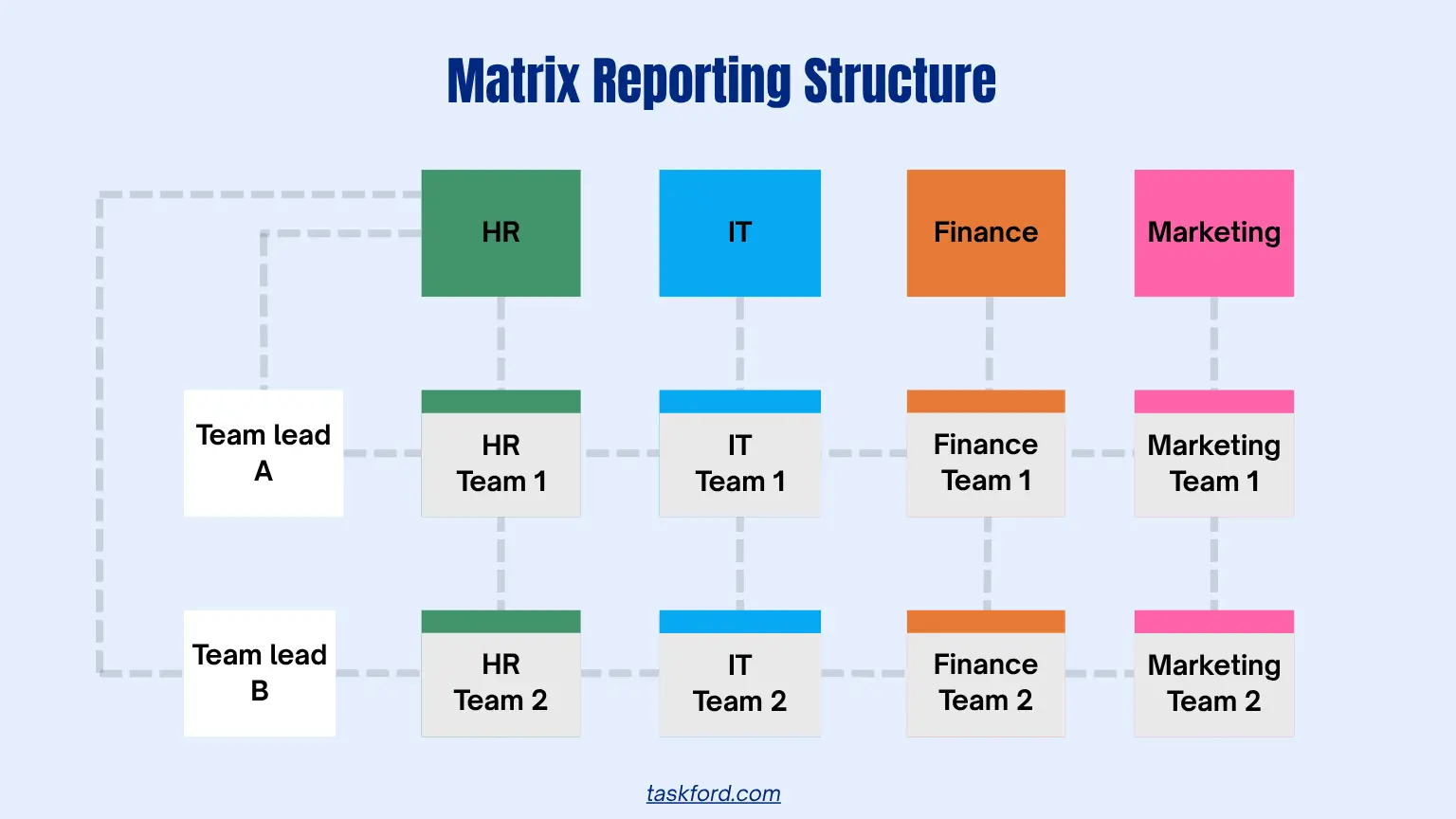
Matrix Leave Management is a specialized approach for organizations with matrix structures, or matrix organizations, where employees report to multiple managers, typically a functional manager for departmental tasks and a project manager for specific initiatives. This dual-reporting model fosters collaboration but complicates leave coordination. A leave management system tailored for matrix organizations centralizes and automates the process, ensuring all stakeholders have clear visibility into absences.
For example, consider a software developer reporting to the IT department head for core responsibilities and a project manager for a product launch. When requesting vacation, both managers must approve the absence to avoid disrupting departmental goals or project timelines. A Matrix Leave Management system automates this by routing requests to the appropriate approvers, tracking leave balances, and maintaining accurate records to prevent miscommunication and scheduling conflicts.
Why Matrix Leave Management Matters
In complex organizations, outdated methods like paper forms, email threads, or spreadsheets create inefficiencies and risks. These manual processes are particularly problematic in matrix structures, where multiple approvals are required, and errors can disrupt operations. A Matrix Leave Management system addresses these challenges by delivering clarity, reducing errors, and supporting compliance and productivity.
Such a system ensures accurate leave tracking and compliance with labor laws, such as the Family and Medical Leave Act (FMLA), preventing payroll discrepancies and legal risks while maintaining transparency through clear leave balances and request statuses. It also provides visibility into team availability, helping managers plan around absences to maintain project timelines and fostering employee trust by ensuring fair processes. By automating and centralizing leave management, organizations save time, enhance fairness, and keep operations running smoothly.
Core Features of Matrix Leave Management
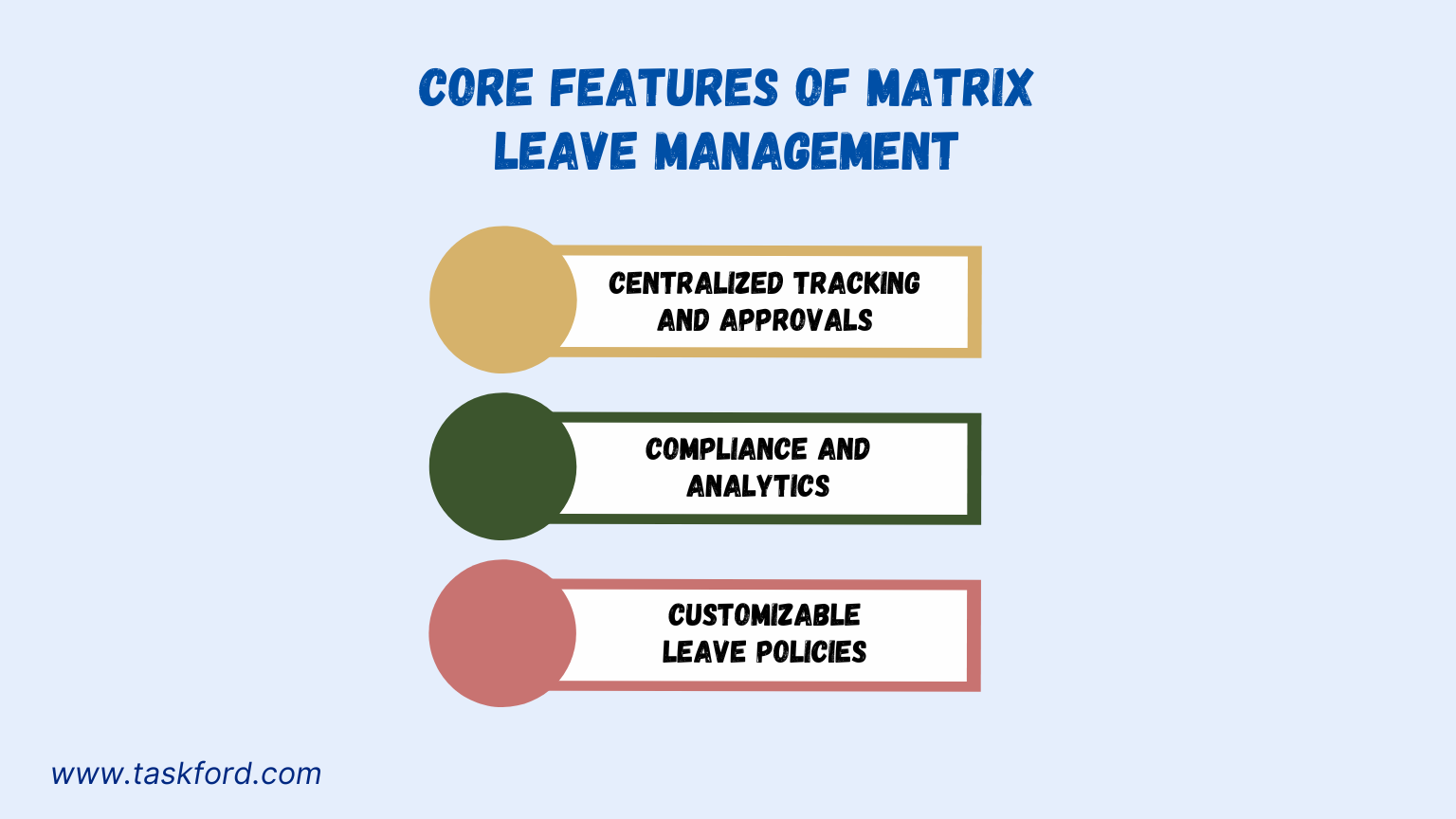
A well-designed Matrix Leave Management system offers tools tailored to the complexities of matrix organizations, ensuring efficient and transparent leave processes. Here are the key features:
- Centralized Tracking and Approvals: A unified platform consolidates all leave data, such as vacation, sick leave, or FMLA, and routes requests to functional and project managers based on predefined rules, ensuring alignment and minimizing conflicts.
- Compliance and Analytics: Built-in tools track compliance with laws like FMLA, calculate accruals, generate audit-ready reports, and provide analytics on leave trends and absenteeism to optimize workforce planning.
- Customizable Leave Policies: The system supports tailored leave types, such as PTO or sick leave, and approval hierarchies, accommodating the unique needs of matrix teams across departments or regions.
Benefits of Matrix Leave Management
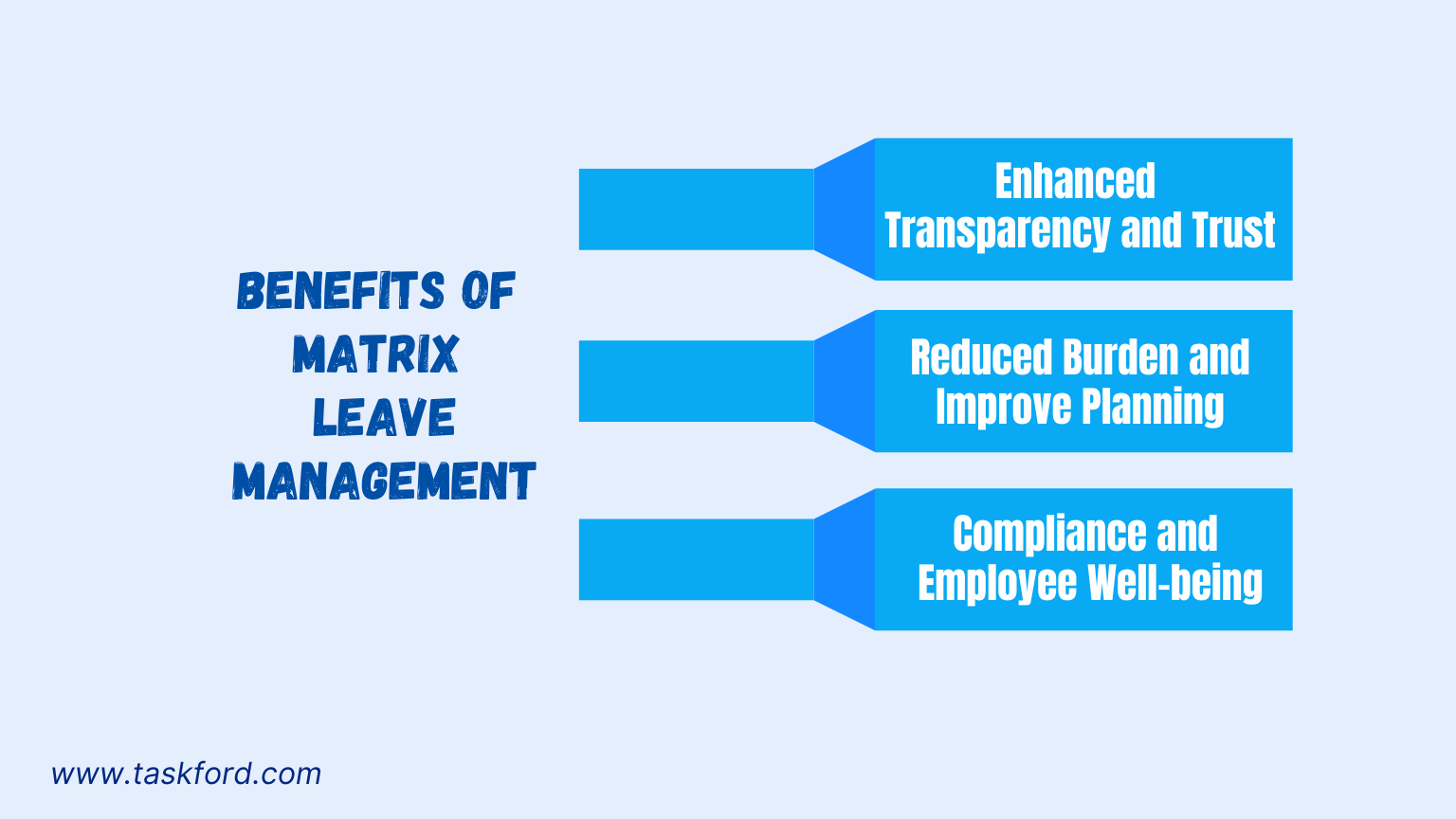
Implementing a Matrix Leave Management system delivers significant advantages for complex organizations, enhancing both operational efficiency and employee satisfaction.
- Enhanced Transparency and Trust: A centralized system provides clear visibility into leave balances and real-time request status updates, ensuring fair processes and building employee confidence in matrix organizations.
- Reduced Administrative Burden and Improved Planning: Automation eliminates repetitive tasks like balance calculations, reduces errors, and provides visibility into absences, enabling managers to plan around project milestones and allocate resources proactively.
- Compliance and Employee Well-Being: The system tracks compliance with labor laws, maintains accurate records to reduce legal risks, and empowers employees to take time off confidently, promoting work-life balance and reducing stress.
TaskFord: Your Partner in Matrix Leave Management
At TaskFord, we understand the complexities of managing leave in matrix organizations, where dual reporting lines and diverse teams demand precision and flexibility. Our leave management system is designed to simplify time-off processes while combining with resource and project management tools to support organizations of all sizes. TaskFord’s platform is recognized for its ability to manage team capacity and provide insights into workload allocation, making it a trusted choice for cross-functional teams.
Why Choose TaskFord?
TaskFord’s leave management platform is tailored for matrix organizations, offering features that address multi-manager approvals, team coordination, and compliance. The following features make TaskFord a standout solution compared to other tools::
- Centralized Leave Request Management: Employees can submit leave requests through a unified platform, with automated routing to functional and project managers, ensuring clear communication and efficient approvals across matrix structures.
- Team Capacity and Availability Insights: Integrated with resource management, TaskFord provides real-time visibility into team availability, helping managers balance workloads and avoid scheduling conflicts during critical project phases.
- Customizable Leave Types: TaskFord supports tailored leave categories, such as annual leave, sick leave, or personal days, allowing organizations to configure policies to meet diverse team needs across departments or regions.
- Compliance Tracking and Reporting: The system tracks compliance with labor laws like FMLA and generates detailed reports on leave trends, enabling data-driven workforce planning and reducing legal risks.
- Multiple Tools: TaskFord’s leave management combines with its project management and resource management tools, ensuring leave data aligns with project schedules, enhancing overall team coordination.
TaskFord’s platform is valued for simplifying complex scheduling tasks and ensuring team availability. Whether managing global teams or project-driven schedules, the platform empowers organizations to handle leave with precision, supporting employee well-being and operational success.
Overcoming Challenges in Matrix Leave Management
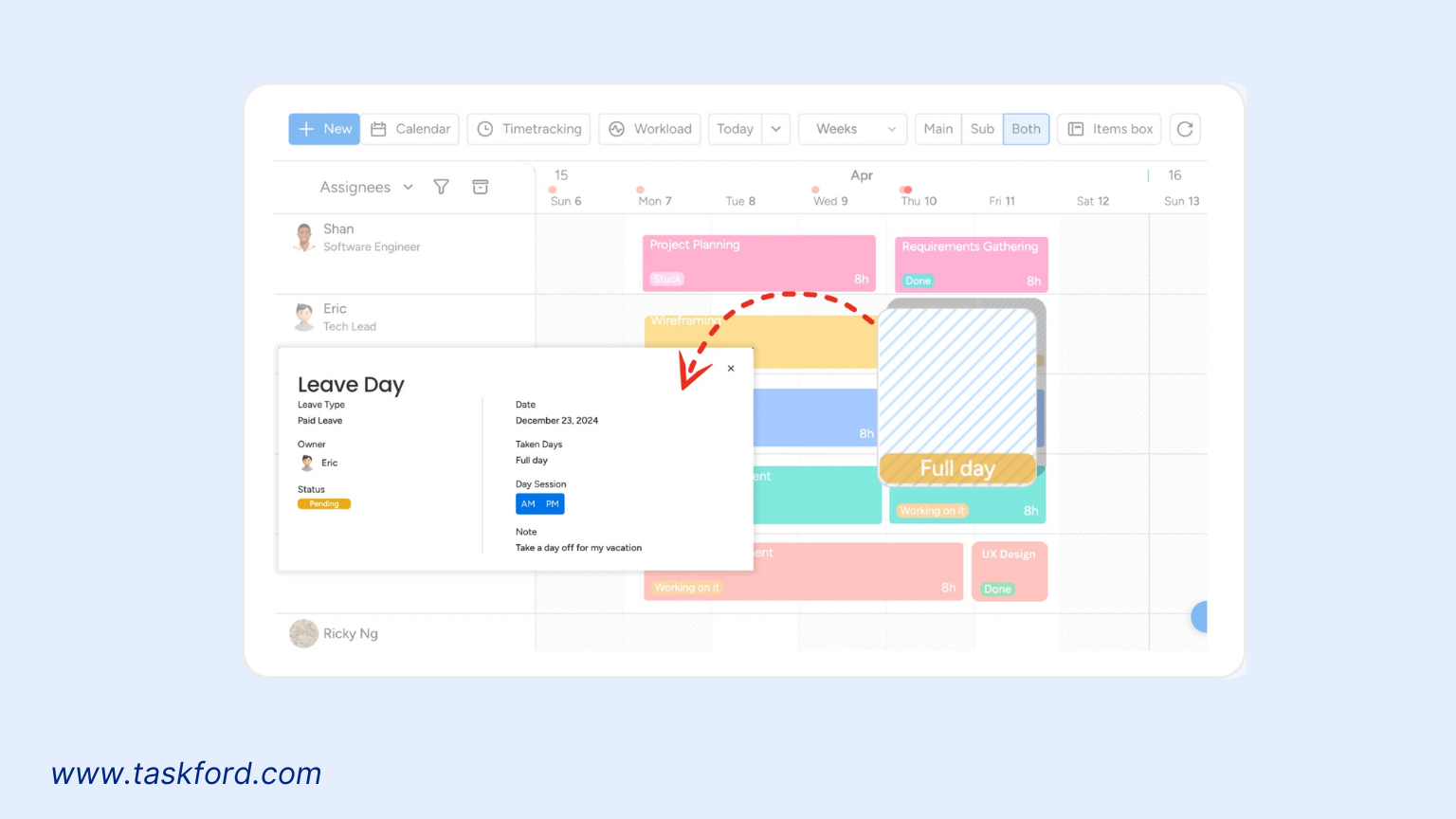
Matrix organizations face unique hurdles in managing employee time off due to their complex reporting structures. A Matrix Leave Management system addresses these challenges effectively:
- Approval Conflicts: Automated routing based on predefined hierarchies ensures requests reach the right managers quickly, flagging conflicts for proactive resolution.
- Communication Gaps: Centralized platforms with real-time updates and notifications keep employees and managers informed, reducing confusion.
- Scalability: Customizable policies and multi-language support accommodate global teams and diverse regulations.
- Workload Balance: Combines with project management tools provides visibility into team availability, enabling effective resource planning.
These solutions ensure clarity, efficiency, and fairness in leave management for complex organizations.
Best Practices for Implementing Matrix Leave Management
To maximize the value of a Matrix Leave Management system, organizations should adopt these best practices:
- Define and Communicate Policies: Establish transparent leave policies, including accrual rules, approval hierarchies, and compliance requirements. Communicate these clearly to ensure alignment across teams and regions.
- Train, Test, and Optimize: Provide comprehensive training on system features for employees and managers. Run a pilot phase to identify and resolve technical issues, and use analytics to monitor leave trends and adjust policies as needed.
- Leverage Existing Systems: Ensure the leave management system combines with payroll, HRIS, and project management tools to create a cohesive ecosystem for workforce planning.
- Maintain Engagement: Keep employees and managers informed about policy changes or system enhancements through regular updates, fostering trust and ensuring consistent use.
- Leverage Analytics: Use leave trend data to identify patterns, such as peak absence periods, and adjust staffing or project plans to maintain productivity.
By following these practices, organizations can fully harness the power of Matrix Leave Management to support their teams and operations.
Case Study: Matrix Leave Management in Action
Consider a multinational tech company with a matrix structure, where employees report to both regional department heads and global project leads. Without a centralized system, leave requests were managed through emails, leading to delayed approvals, scheduling conflicts, and compliance issues. After implementing TaskFord’s leave management system, the company saw significant improvements:
- Faster Approvals: Automated routing reduced approval times by 60%, as requests were instantly sent to the correct managers.
- Improved Compliance: The system ensured adherence to regional labor laws, reducing legal risks and ensuring accurate FMLA tracking.
- Enhanced Planning: Managers gained real-time visibility into team availability, enabling better resource allocation for critical projects.
- Employee Satisfaction: Employees appreciated the transparent, user-friendly portal, leading to a 20% increase in positive feedback on leave processes.
Conclusion
Matrix Leave Management transforms how complex organizations handle employee time off. By addressing challenges like multi-manager approvals and global compliance, a leave management system ensures transparency, efficiency, and employee well-being.
Ready to simplify leave management? Join TaskFord's waitlist now to ensure an efficient, transparent leave management process.
Learn more
- 5 Red Flags to Watch for in Your Leave Tracker Data
- 5 Steps to Master the Human Resource Management Planning Process
- 5 Critical Mistakes When Using a Resource Planning Program and How to Overcome Them
Making work simpler,
smarter, and more connected
Join our waitlist and be notified first.

Related Blog
Subscribe for Expert Tips
Unlock expert insights and stay ahead with TaskFord. Sign up now to receive valuable tips, strategies, and updates directly in your inbox.

